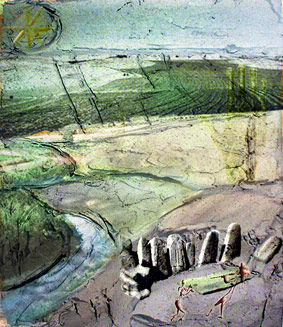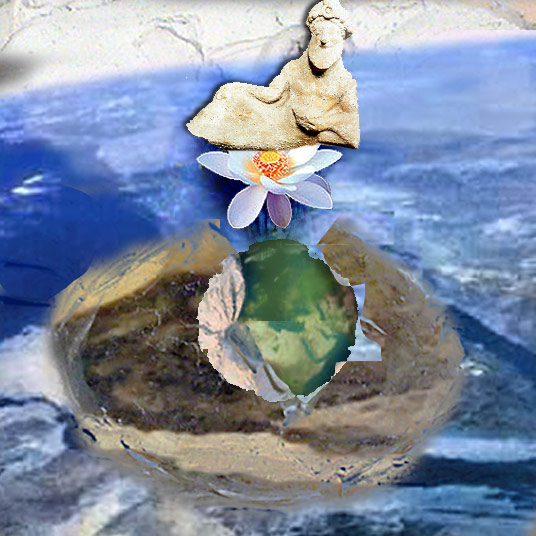|
The Project of Historical Path at King
Hussein Park The Historical Path will be a 488 meter long wall, 4-6 meters height. The wall will contain openings to present 57 different pieces of fine art in varies designs and materials according to the historical period it will represent. The artwork will present Jordan's history from the Stone Age (4000 BC) until now. The Owner of the project is Municipality of Greater Amman. Following are the proposal sketches for eight sculptures for the Project of Historical Path at King Hussein Park by Kathy Forer. |
Iron Age
13- Porcelain mural represents the cycle of fertility and dryness, and the weather cycle according to Moabite mythology.
5.4' x 6.2' x 9.8"
15- Porcelain mural represents Balaq the king of Moab asking Balaam to construct 7 slaughter places for sheep sacrifice.
5.4' x 6.2' x 9.8"
22- Porcelain mural represents the Egyptian civilization effects on Edomite mythology
29.5" x 29.5" x 7.8"
23- Porcelain mural represents the Egyptian civilization effects on Edomite mythology.
29.5" x 29.5" x 7.8"
24- Porcelain mural represents the Edomite mythology.
7.3' x 7.3' x 7.8"
25- Porcelain mural represents the fighter riding his horse carriage at the Edomite mythology.
29.5" x 29.5" x 7.8"
Byzantine Period
35- Corniced column crown made of bronze (and metal column).

19.6" x 21.6" x 19.6"
This column would be a regular Byzantine Corinthian column with the slightly unusual addition of Nabatean elephant heads.
The four sides of the bronze column will be replicated from a one-sided clay model. The capital will have hardware provisions for installation on an on-site metal column. Depending on materials, it will probably be welded to the column base.
37- Bronze or copper bell represents the Byzantine churches.
31.5" x 39.4" x 31.5"
The shape of the bell profile will be modeled after a pot from a local excavation. The low relief decoration of Byzantine era churches will be derived from the Madaba Map.
The foundry will mill a full-size foam blank from a drawn or computer-modeled profile. The surface will then be modeled in low relief (approx. 1/4 inch) in wax. The foundry will make a sand-cast bronze of this model.
![]()
![]()
Description of the art works
STONE AGE
- Stone sculpture back to Natufian culture, which concentrated on animals such deer, pigs etc, this sculpture represents natufian human back to Mesolithic age. [Pero Jaksic]
- Same as item 1 but the sculpture look like human. [Pero Jaksic]
- Same as item 1 but the sculpture is natufian human called "The Lovers". [Pero Jaksic]
- Same as item 2. [Pero Jaksic]
- Same as item 2. [Pero Jaksic]
- Stone sculpture similar to the sculpture found in Zowela, represents hunted animals kinds at neolithic age. [Pero Jaksic]
- Same as item 6, but represents hunter's shapes and movements. [Pero Jaksic]
IRON AGE
- Stone sculpture represents Ashtar Milcom at Ammonite period. [Pero Jaksic]
- An abstract mural made of copper and bronze represents the Ghasolic culture at copper period, it contains three octagon stars inside each others which is the most important and beautiful mural in the near east, and 3 persons carrying strange tools. [Dale Enochs]
- Black stone sculpture similar to Eygptian Osiris, at Edomite period which represents the egyptian period in Jordan. [Mirza Moric/Michael Pegler]
- Bronze mural represents the Moabite lettering of Mesha story. [George Denninger]
- Same as item 11. [George Denninger]
- Porcelain mural represents the cycle of fertility and dryness, and the weather cycle according to Moabite mythology. [Kathy Forer]
- Black stone sculpture represents the fighter at 12th century B.C. [Mirza Moric/Michael Pegler]
- Porcelain mural represents Balaq the king of Moab asking Balaam to construct 7 slaughter places for sheep sacrifice. [Kathy Forer]
- Same as item 11. [George Denninger]
- Same as item 11. [George Denninger]
- Same as item 11. [George Denninger]
- Stone sculpture represents Eagle from 12th century B.C. (HELLENISTIC PERIOD) [Ali Noori]
- Same as item 19 but represents Lion.(HELLENISTIC PERIOD) [Ali Noori]
- Porcelain mural represents the Egyptian. Same as item 19 but represents Tiger. ( HELLENISTIC PERIOD) [Ali Noori]
- Porcelain mural represents Egyptian civilization effects on Edomite mythology. [Kathy Forer]
- Same as item 22. [Kathy Forer]
- Porcelain mural represents the Edomite mythology. [Kathy Forer]
- Porcelain mural represents the fighter riding his horse carriage at the Edomite mythology. [Kathy Forer]
- Mixed material mural represents the Nabatean mythology signs. (HELLENISTIC PERIOD) [Dale Enochs]
- Stone mural represents Tyche of luck at the center of Zodiac. (HELLENISTIC PERIOD). [Mirza Moric/Michael Pegler]
ROMAN AGE
- Mixed materials sculpture represents Aphrodite the sign of love and beauty. [Kobi Harel]
- Mixed material sculpture represents the sign fertility holding the horn of fertility. [Kobi Harel]
- Same as item 29 but represents the peace and war signs. [Kobi Harel]
- Mixed materials sculpture represents Romulus and Remus feed from the wolf. [Kobi Harel]
BYZANTINE AGE
- Bronze mural represents the district map of east Jordan and Wadi Araba. [Dale Enochs]
- Mosaic mural represents the Byzantine art. [Laura DiNello]
- Mosaic mural represents the Holy Lands map. [Laura DiNello]
- Corniced column crown made of bronze and metal column. [Kathy Forer]
- Mosaic mural represents drawing of Jordanian and Palestinian cities similar to the same existing in Madaba Churches. [Laura DiNello]
- Bronze or copper bell represents the Byzantine churches. [Kathy Forer]
ISLAMIC AGE
- Mosaic or colored marble mural represents the leader Salah Eddin Ayyubi . [Laura DiNello]
- Copper and iron mural represents the Hijaz railway map. [George Denninger]
MODERN AGE
- Mixed material mural tells about the life of Sharif Hussein and the Arab great revolution. [Edward Walsh]
- Mosaic mural represents Sharif Hussein. [Laura DiNello]
- Same as item 39 tells about King Abdullah I. [Edward Walsh]
- Same as item 40 but represents King Abdullah I. [Edward Walsh]
- Mixed materials mural represents the historical, religious values of Jerusalem. [Edward Walsh]
- Abstract mixed material mural represents the old city of Jerusalem and some of religious places. [Edward Walsh]
- An abstract mural sheet made of (metal, copper, stainless steel) represents the old city of Jerusalem map with some of its holy places. [Edward Walsh]
- An abstract mural sheet made of (metal, copper, stainless steel) represents the Hashemites took care of the holy places in Jerusalem and the processing of gold plate the dome of Aqsa mosque. [Edward Walsh]
- An abstract mural sheet from different materials (granite, bronze, stone, steel, concrete, chemical staining) symbolizes the life and achievements of King Talal bin Abdullah includes the preliminarily education and social security. [Don Frost]
- An abstract mural sheet made of colored marble or mosaic represents King Talal bin Abdullah. [Laura DiNello]
- An abstract mural sheet from different materials (granite, bronze, stone, steel, concrete, chemical staining) symbolizes the life and achievements of King Hussein bin Talal, includes some of his famous speeches and thoughts, some of his life time. [Don Frost]
- An abstract mural sheet made of colored marble or mosaic represents King Hussein bin Talal. [Laura DiNello]
- An abstract mural sheet from different materials (granite, bronze, stone, steel, concrete, chemical staining) symbolizes to the great achievements in King Hussein age's and his great love to his Jordanian family. [Bozena Happach] ?
- An abstract mural sheet from different materials (granite, bronze, stone, steel, concrete, chemical staining) symbolizes one of the important achievements on the agricultural level in King Hussein's age. [Bozena Happach]
- An abstract mural sheet from different materials (granite, bronze, stone, steel, concrete, chemical staining) symbolizes one of the important achievements on the Urban level in King Hussein's age. [Bozena Happach]
- An abstract mural sheet from different materials (granite, bronze, stone, steel, concrete, chemical staining) symbolizes one of the important achievements on the Industrial level in King Hussein's age. [Bozena Happach]
- An abstract mural sheet from different materials (granite, bronze, stone, steel, concrete, chemical staining) symbolizes one of the important achievements on the Political level in King Hussein 's age. [Bozena Happach]
- An abstract mural sheet made of colored marble or mosaic represents King Abdullah II. [Laura DiNello]
- An abstract mural sheet from different materials (granite, bronze, stone, steel, concrete, chemical staining) symbolizes one of the important achievements on the scientific level in King Hussein's age. [Don Frost]
Original Team Members
George Denninger http://www.denninger-designs.com/
Laura DiNello http://lauradinello.com
Dale Enochs* http://home.bluemarble.net/~denochs/
Kathy Forer http://www.kforer.com/
Don Frost* http://www.donfrostsculpture.com/
Bozena Happach* http://bohappach.netfirms.com/
Kobi Harel http://kobiharel.com/
Pero Jaksic http://perojaksic.com
Mirza Moric http://www.pcl.fr/moric/
Ali Noori http://absolutearts.com/portfolios/n/noori/
Michael Pegler http://www.mpegler.enta.net/
Edward Walsh* http://walsh-sculpture.com/
*Final Team







